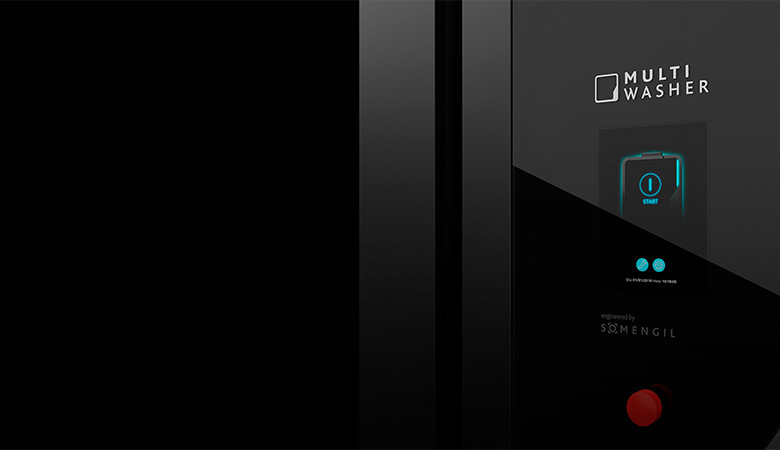Lavagem Industrial / Artigos
Soluções antissépticas: o que são e porque são importantes
As infeções hospitalares são uma das principais causas de morte em todo o mundo. Descubra como as soluções antissépticas ajudam a controlar este risco.

 10 minutos de leitura
10 minutos de leitura
2022-06-02 17:09:53
As soluções antissépticas são uma das mais importantes ferramentas de combate às infeções hospitalares, um dos principais flagelos com que a área hospitalar se depara. Este não é um problema exclusivo de economias em desenvolvimento - nos países da OCDE, cerca de 4 milhões de pessoas por ano são vítimas de infeções em meio hospitalar. Só na União Europeia, estimam-se mais de 90.000 mortes anuais relacionadas diretamente com este problema, que representa em média 6% do orçamento de cada Hospital (European Centre for Disease Prevention and Control).
Descubra o que são soluções antissépticas e em que medida ajudam a controlar o risco de infeções em ambiente hospitalar.
O que são as soluções antissépticas?
As soluções antissépticas são medicamentos que têm como objetivo reduzir, eliminar ou inativar microrganismos em tecidos vivos. Diferem do ato de desinfetar na medida em que este último se aplica apenas e só em meios inertes contaminados, ao passo que as soluções antissépticas se aplicam em tecidos vivos.
Apenas se obtém uma real ação antisséptica se a superfície estiver previamente limpa, enxaguada e seca, pelo que estes primeiros passos são decisivos para a eficácia dos seguintes. As soluções antissépticas atuam de duas formas: por inibição ou por letalidade. Dito doutro modo, podem obstar ao crescimento dos microrganismos ou ir mais longe e matar bactérias, vírus e fungos.
Alguns antissépticos reúnem estas duas ações em simultâneo, estando a eficácia associada à velocidade do efeito letal. Apesar da sua rapidez de ação, exercem também um efeito residual prolongado e persistente, sobretudo na ausência de enxaguamento. Algumas das soluções antissépticas mais usadas em Portugal são o álcool, a clorohexidina e a iodopovidona (substância presente, por exemplo, no medicamento Betadine).
A utilização destas e outras soluções traz vários benefícios em ambiente hospitalar, para a saúde dos pacientes e dos profissionais.
Quais as vantagens das soluções antissépticas hospitalares?
A mobilidade dos profissionais de saúde, muitas vezes sem os adequados cuidados, aliada a um processamento inadequado de materiais e fluidos, constituem um cenário favorável ao desenvolvimento de infeções. As soluções antissépticas desempenham assim um papel fundamental nas práticas de controlo e prevenção de infeções - seja na assistência a pacientes em hospitais, atendimento ambulatório, clínicas ou consultórios.
Nestes ambientes, a prevenção começa com algo tão simples como a lavagem das mãos. Uma vez que as mãos entram em contacto direto com áreas anatómicas e materiais potencialmente infetados, a proteção, para ser eficaz, deve ser a primeira prioridade.
De seguida, qualquer ação clínica ou médica deve ser antecedida pela assepsia das áreas anatómicas intervencionadas, como, por exemplo, as mucosas associadas à inserção de cateteres, a desinfeção da pele para a preparação da cirurgia, bem como o tratamento de infeções da pele, da boca e da garganta.
O ambiente operatório sempre foi percecionado como a área onde os cuidados assépticos se revestem de uma importância ainda maior. A singularidade deste espaço, aliada à complexidade de procedimentos e intervenções que nele decorrem, torna-o o local onde há maior grau de assepsia e adesão às técnicas de esterilização.
Quais são as soluções antissépticas mais comuns?
As soluções antissépticas têm uma aplicação praticamente transversal a todos os processos terapêuticos e cirúrgicos.
O álcool é uma das soluções antissépticas mais utilizadas para desinfetar as mãos – a simples fricção diminui de forma significativa a presença e transmissão de microrganismos, com consequente queda nas taxas de infeções hospitalares. Além disso, é muito bem tolerado pela pele, apresenta um baixo nível de toxicidade e tem uma ação rápida, sem representar um custo significativo na gestão financeira hospitalar.
A clorohexidina é também usada para desinfetar as mãos e, sobretudo, para antissepsia bucal. Apresenta também bons resultados contra a colonização e infeção bacteriana decorrente de colocação de cateteres vasculares e epidurais.
A utilização de iodopovidona também tem sido recomendada para a inserção de cateteres intravasculares (e ao longo da sua manutenção), e especialmente para a desinfeção do trato urogenital interno e externo e cateterização da bexiga. É amplamente utilizada para desinfetar pele lesionada, como é o caso de feridas, úlceras nas pernas e queimaduras.
Como utilizar soluções antisséticas?
A utilização de soluções antisséticas exige vários cuidados, para que de facto seja eficaz e proteja quem os utiliza. Estas são as 4 principais recomendações a seguir.
1. Respeite o modo de utilização e conservação
A primeira e mais óbvia recomendação é que estas soluções devem ser utilizadas sobre os tecidos vivos – como a pele e mucosas – e não em materiais como para desinfetar recipientes. Outra dica a não esquecer é que a antissepsia se pratica apenas em tecidos previamente limpos, após uma limpeza, enxaguamento e secagem da zona.
É fundamental respeitar o modo de emprego, concentração e tempo de contacto do antisséptico, assim como as datas de validade. A conservação é outro ponto crítico e as soluções devem ser armazenadas ao abrigo da luz e do calor, principalmente se forem inflamáveis
2. Tenha atenção às incompatibilidades
Como qualquer outro medicamento, a maioria das soluções antissépticas tem contraindicações, que devem ser respeitadas. As principais estão relacionadas com a idade dos pacientes, mas podem igualmente existir restrições a nível dos tecidos a aplicar. O mesmo acontece com os produtos de lavagem utilizados no momento prévio à antissepsia. Por exemplo, é comum o registo de incompatibilidades com Dakin ou Clorohexidine. É ainda importante não misturar ou empregar sucessivamente dois antissépticos: deve sempre utilizar a mesma família destes medicamentos.
3. Imponha limites ao uso de antissépticos
A utilização dos antissépticos deve ser regrada, e há várias formas práticas de o fazer. A primeira é individualizar os antissépticos utilizados nos doentes em isolamento de contacto, para evitar que sejam reutilizados noutros pacientes. Após a alta, os frascos devem ser descartados. Para evitar misturas que colocariam os doentes em risco, limite o número de antissépticos utilizados no mesmo serviço e evite o armazenamento de grandes quantidades nos postos de cuidados. Utilize de preferência doses unitárias ou embalagens pequenas, para facilitar a limpeza entre duas utilizações.
4. Crie uma política de gestão de antissépticos
Para promover uma utilização correta e uniforme dos antissépticos, é necessária uma política específica para a gestão de todo o seu ciclo de vida – da compra ao descarte. De preferência, este guia deve ser elaborado por um grupo multidisciplinar, composto por farmacêuticos, médicos e enfermeiros. O protocolo de gestão deve ser documentado, validado e auditado regularmente, e pode ter várias formas, de checklists a fluxogramas. De seguida, deve ser disseminado por toda a equipa através de formação e treino prático.
O meio hospitalar é, pela sua natureza, propício ao natural desenvolvimento de bactérias nocivas à saúde humana, e o desafio está em assegurar, diariamente, a segurança tanto dos pacientes como dos profissionais de saúde.
Em linha com esta preocupação, a Somengil desenvolveu um equipamento de lavagem industrial de última geração, especialmente dirigida ao setor hospitalar. A MultiWasher Healthtech recorre à mais recente tecnologia para aliar, de forma única no mercado, altas temperaturas e detergentes ecológicos, no sentido de eliminar o risco de propagação de doenças.
Entre em contacto para descobrir o seu funcionamento, e veja como fará a diferença na gestão logística da sua unidade de saúde. Agende também um webinar, para assistir a uma atualização das tendências relativas à lavagem e desinfeção aplicadas à indústria alimentar, de catering e food service.
Também pode gostar

Lavagem Industrial / Artigos
HostMilano 2023: viagem ao centro do food service internacional
Estivemos na HostMilano, uma das maiores feiras internacionais de food service e hospitalidade. Descubra as principais novidades.
Postado em 2024-01-03

Lavagem Industrial / Artigos
Sistemas de secagem: o que são e como escolher um
Descubra o impacto real dos sistemas de secagem nas suas operações quotidianas e saiba como escolher um.
Postado em 2024-12-13

Lavagem Industrial / Artigos
Máquinas de lavar industriais: como escolher?
As máquinas de lavar industriais são decisivas para aumentar a eficiência do processo de lavagem. Saiba o que ter em conta quando escolher este e...
Postado em 2021-08-10






















 Portugal
Portugal United Kingdom
United Kingdom United States
United States France
France Spain
Spain Germany
Germany Romania
Romania Italy
Italy Czech Republic
Czech Republic Finland
Finland Hungary
Hungary Slovakia
Slovakia Greece
Greece Lithuania
Lithuania South Korea
South Korea Russia
Russia Saudi Arabia
Saudi Arabia Poland
Poland Brasil
Brasil Hebrew
Hebrew